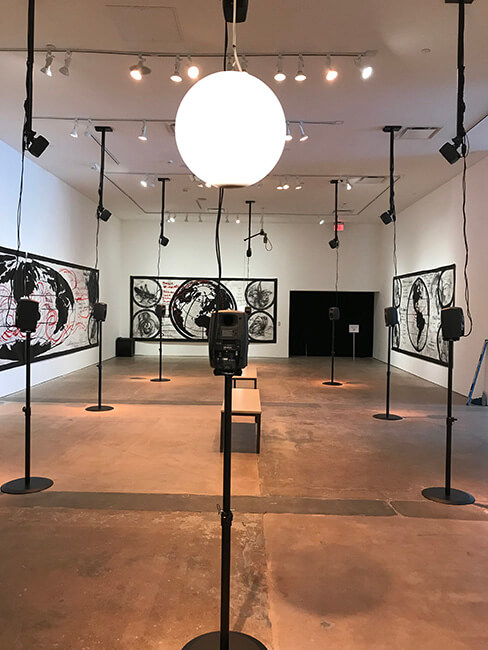Work in Progress with Oswaldo Maciá

The following article was originally published by Southwest Contemporary.
“I am an artist always on the move,” said Oswaldo Maciá days before the opening of his first exhibition in the United States, New Cartographies of Smell Migration. “My canvas is the whole planet.”
We sat in the museum lobby at SITE Santa Fe, where New Cartographies opened for a month-long showing on October 1, 2021. Maciá is known for thinking about sculpture on a molecular level, using smell and sound to highlight the circulation of air. Maciá, whose artworks directly engage multiple senses, creates a framework to guide viewers towards new questions about coexistence, influence, and migration.
“Sculpture is an olfactory acoustic composition,” he said. “Smell is like a vertical sculpture. Sound is like a horizontal sculpture.”
Not surprisingly, an artist who combines nontraditional media like smell and sound doesn’t have a typical studio practice. Maciá creates scents with a Dutch perfume company and travels the world collecting field recordings of migratory winds, insects, and animals—creatures and elements that facilitate healthy ecosystems regardless of human borders. Most recently, he’s been chasing an elusive desert hum.
“This is a difficult sound to catch,” Maciá said. “Deserts make this sound at a particular day and time, under particular conditions. Sand particles float on the surface of the sand. You don’t see anyone, but it sounds like a hundred people humming.”
Capturing this sound requires special attention, one that has turned Maciá onto the environment’s inherent aesthetic properties. “When you listen to wind, it has silence, repetition, volume, softness, quietness—the wind has all the words we are using to describe something aesthetic,” he said. “We need to have allegro, we need to have andante, but all of those concepts appear when you record the natural world.”
Maciá’s attentiveness emerges from an ambulant education. Born in Cartagena de Indias, Colombia, he first moved to Bogotá to study advertising, relocated to Barcelona to study murals, and then headed to London where he earned an MFA from Goldsmiths, University of London, and a BA from London Guildhall University. “Philosophers, artists in history—they’re always on the move,” he said.
His multidisciplinary background has produced installations like Surrounded in Tears (2004), a catalogue of more than 100 sampled recordings of human cries broadcasted through twenty-two megaphones, as well as The Opera of Cross-pollination (2018), an installation combining field recordings of insects, the sound of metal, and the smell of cross-pollination.
Maciá has exhibited widely around the world including Tate Britain, Manifesta 9, Venice Biennale, Riga International Biennial of Contemporary Art, and MOCO Montpellier Contemporain. Something Going On Above My Head (1995-1999) is currently on view at London’s Tate Modern and features more than 2,000 bird call recordings assembled in the fashion of a classical music orchestra.
New Cartographies of Smell Migration was originally commissioned by German art museum Kunsthalle Bremen as part of With the Eyes Smell: Odor Patterns Since the Renaissance. Adapted for SITE Santa Fe, the New Mexico iteration includes six large-scale, annotated map paintings of the Earth. The installation features a sixteen-channel sound collage of migratory winds and insects from the Colombian rain forest, two scent diffusers at opposite poles of the gallery, scented hand soap in the bathroom, and twenty-five intimate portraits of migratory insects, plants, and birds hung salon-style in the lobby.
The smell of Peru Balsam fills the gallery via two moon-like orb diffusers suspended from the ceiling—infiltrating the viewer’s experience and calling forth the planet’s longstanding, multi-species exchange of material, influence, knowledge, and pollen.
Smells remind us that the body is porous and constantly engaged in an intimate and reciprocal exchange with the environment. It also bypasses the part of the brain that manages alertness and consciousness. This, Maciá suggests, will yield new insight and thoughtfulness.
“We do not have language for smell,” Maciá said. “We talk in metonymies: we talk about ‘floral.’ We talk about ‘wooden.’ ‘Metal’ smell—what kind of metal? Copper. Bronze. So you build the rest.” He adds, “To understand the world, you need to smell the world.”
Oswaldo Maciá: New Cartographies of Smell Migration continues through October 31, 2021 at SITE Santa Fe, 1606 Paseo De Peralta.